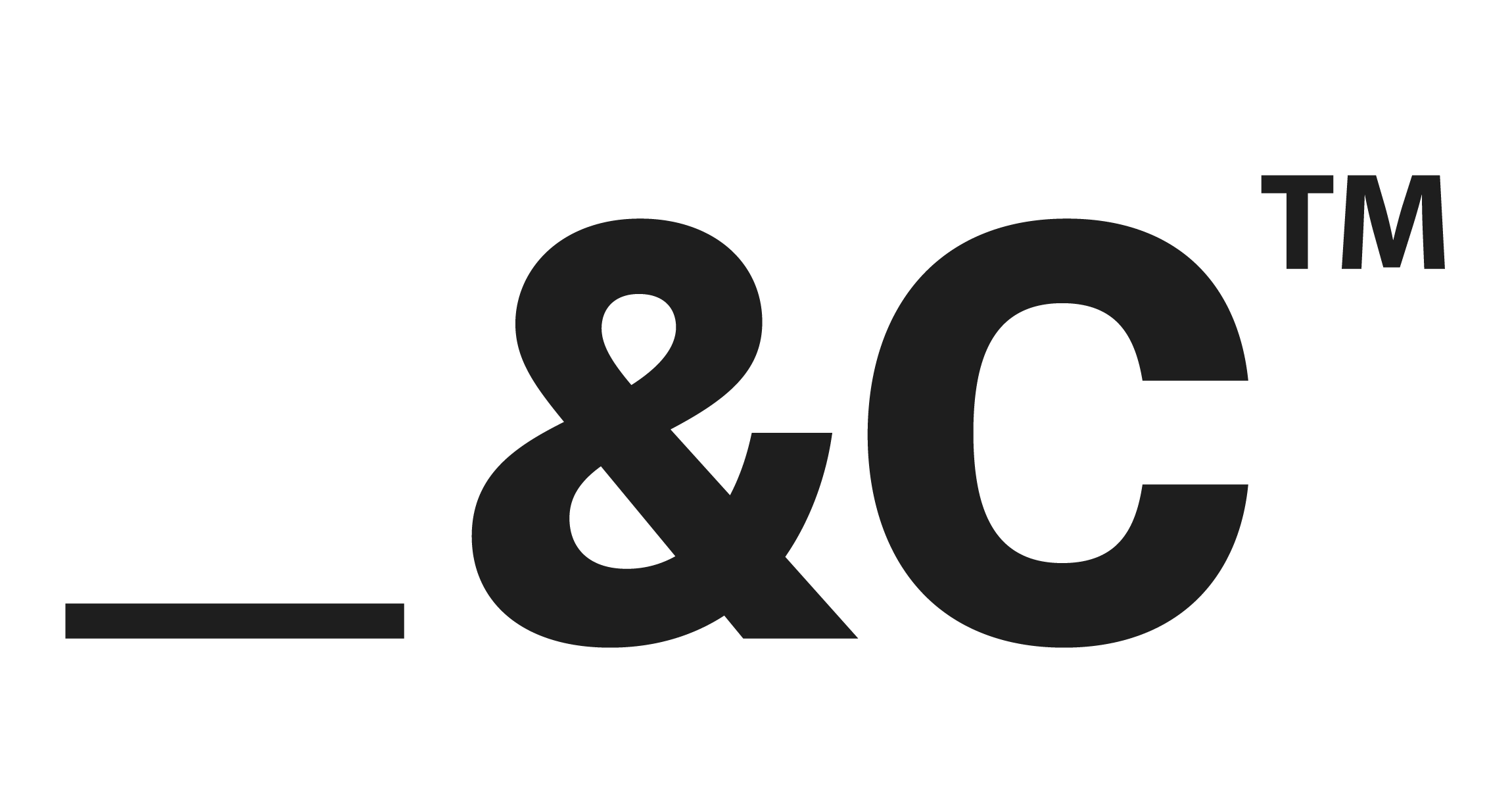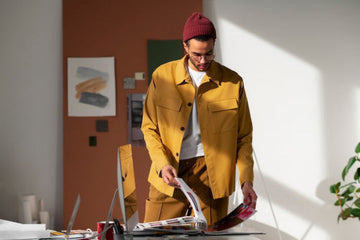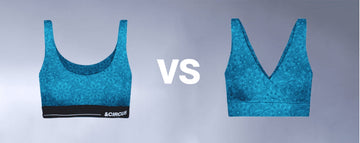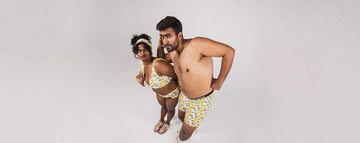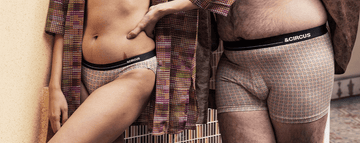Quick Listen:
Picture this: a world where your favorite loungewear doesn't just flatter your silhouette but anticipates your every move, easing the subtle strains of daily life without a whisper of compromise. For decades, the fashion realm has marginalized those grappling with disabilities, chronic illnesses, or the inevitable shifts of aging offering outfits that dazzle from afar yet betray their wearers up close. Now, a transformative wave of adaptive designs is reshaping the narrative, fusing cutting-edge ingenuity with eco-conscious ethos to deliver attire that empowers rather than encumbers.
Uncomfortable underwear shouldn't steal your confidence. At Andcircus, we craft ultra-soft, sustainable Lenzing Modal Micro® innerwear for every body, XS to 5XL. From briefs to bras, our custom packs fit you perfectly. Shop risk-free with our 100% satisfaction guarantee and embrace comfort that includes everyone. #LoveEveryBody. Shop Now!
Innovative Adaptive Designs Revolutionizing Inclusive Fashion for All
Adaptive fashion represents far more than a fleeting trend; it embodies a profound evolution, embedding accessibility directly into the warp and weft of modern apparel. This paradigm reconfigures garments to accommodate individuals facing physical limitations, persistent health issues, or the natural progression of years, transforming the ritual of dressing from a potential ordeal into an effortless extension of self-expression. Pioneering labels such as AndCircus exemplify this ethos through their commitment to sustainable underwear and loungewear tailored for both genders, demonstrating that unparalleled comfort can coexist seamlessly with environmental stewardship and aesthetic flair. With consumer appetites for such considerate craftsmanship intensifying, one truth stands resolute: true inclusivity has ascended from mere aspiration to the foundational pillar of sustainable style.
This metamorphosis reflects a seismic shift across the sector, where buyers in dynamic locales like Maharashtra, Karnataka, and Tamil Nadu hubs of bustling urban rhythms seek wardrobes that flex with their realities rather than impose rigid constraints. Social channels, from Instagram's visual vignettes to YouTube's narrative deep dives, amplify these imperatives through authentic testimonials from tastemakers such as @desouzamesty and @shainatanna, who candidly unpack the triumphs and tribulations of adaptive dressing. Such discourse has propelled the adaptive clothing sector into stratospheric growth, with projections estimating a valuation of USD 18.5 billion in 2025, surging toward USD 32.12 billion by 2032 at a compound annual growth rate of 8.2 percent. Europe commands the vanguard with a 45.4 percent market share in 2025, anchored by trailblazers like Zappos Adaptive, Tommy Hilfiger Adaptive, and Marks & Spencer Adaptive. North America trails robustly at 29.6 percent, propelled by sobering demographics: according to the Centers for Disease Control and Prevention, roughly 14 to 16 percent of U.S. residents contend with disabilities as of May 2023. Meanwhile, Asia Pacific's 18.4 percent foothold hints at explosive horizons, especially in burgeoning economies like India and South Korea, where healthcare advancements and cultural pivots toward equity are accelerating adoption.
Yet, this momentum draws from deeper wellsprings. An aging global populace, swelling in numbers, necessitates apparel that facilitates unhindered donning, superior comfort, and fluid mobility tailored precisely to mitigate the physical hurdles of later life. Concurrently, heightened societal consciousness around disabilities has galvanized designers to forge inclusive ensembles that address the nuanced dressing demands of those with motor or cognitive impairments. These catalysts, as delineated in comprehensive market analyses, underscore a trajectory where adaptive innovations not only meet functional imperatives but elevate the human experience of fashion itself.
Emerging Trends in Adaptive Fashion
In the crucible of contemporary design, sustainability and accessibility have forged an unbreakable alliance, emerging as the dynamic duo redefining adaptive apparel. Envision textiles born from reclaimed marine waste supple, resilient materials that contour to non-conventional forms while championing planetary health. Forward-thinking houses are championing this synergy, curating assortments that honor ecological imperatives without sacrificing tactile delight or ergonomic precision. The ascent of gender-fluid silhouettes exemplifies this ethos: motifs that transcend traditional divides, inviting universal embrace in the sweltering streets of Delhi or the tranquil retreats of Kerala.
At the heart of this renaissance lies technological prowess, ingeniously interlaced into the very threads of possibility. Intelligent textiles, laced with microsensors, vigilantly track ergonomic alignment or thermal fluctuations, while innovative fasteners like magnetic clasps supplant archaic mechanisms lifelines for those navigating arthritis or convalescence. Innovation, however, often thrives in restraint; AndCircus's hallmark fuss-free architecture exemplifies this philosophy, excising superfluous elements to liberate the user for life's unscripted pursuits. As enlightenment proliferates illuminated by stark global metrics revealing over one billion individuals, comprising 15 percent of humanity, contending with disabilities these evolutions transcend marginality, cementing their status as indispensable imperatives in the sartorial lexicon.
Moreover, creators are expanding their visionary scope, architecting solutions for an expanse of exigencies: from fluid interfaces for mobility device users to hypo-irritant havens devoid of abrasive labels for the sensory-attuned. Gender-agnostic motifs, in particular, shatter the myth of prescriptive aesthetics, deploying vibrant tableaux that adorn every contour with equitable verve. This expansive ethos permeates generational boundaries as well consider elasticized bands accommodating weight variances or streamlined pulls aiding the venerable. Such progressions are twin tributes to compassion and craftsmanship, recalibrating the essence of adornment amid Uttar Pradesh's sultry monsoons or Gujarat's kaleidoscopic revelries. AndCircus amplifies this through their signature fabric mix, a masterful blend yielding unparalleled softness and tenacity, ensuring that sustainability never cedes ground to subpar sensation.
Real-World Applications and Case Studies
Step into premier emporiums or navigate the curated collages of Pinterest, helmed by grassroots champions, and adaptive fashion's imprint is indelible. AndCircus distinguishes itself amid this tapestry, their oeuvre a testament to triple-threat ingenuity: the bespoke fabric alchemy delivering silken fortitude, prints unmoored from gender norms igniting unbridled delight sans clichés, and streamlined builds elevating repose to regal indulgence. Far from novelties, these hallmarks resonate with lived exigencies the Delhi executive balancing virtual vigils and assistive apparatuses, or the Kerala household pursuing verdant essentials resilient against seasonal deluges.
Venturing further afield, the panorama pulses with provocation. Tommy Hilfiger's adaptive vanguard, for instance, unveiled ingress-facile denim with malleable cuffs, affirming that opulence can manifest tangibly. Europe's preeminence, as the sector's lodestar, spotlights fixtures like Marks & Spencer Adaptive, proffering an arsenal from tactile-compliant hosiery to rear-access gowns. These triumphs coalesce into a surging tide. A rigorous qualitative inquiry in South Korea dissected the multifaceted impediments confronting men with physical impairments in apparel acquisition, employing grounded theory to probe beyond mere mechanics unearthing sociopsychological fissures and consumption dynamics that sculpt these obstacles. Drawing from intimate dialogues with nine affected gentlemen and four caretakers, augmented by immersive fieldwork that cultivated profound trust, the probe advocates for a holistic marketplace enveloping able and disabled alike, irrespective of corporeal variance. Adaptive attire, calibrated for bespoke necessities, has accrued velocity as a conduit for fulfillment, though scant scholarship citing works like those of Chae in 2022 or McBee-Black and Ha-Brookshire in 2020 has plumbed the emotional and transactional thorns entwined with such engagements. Respondents evoked a profound impotence in ceremonial garb, where mundane fasteners symbolize systemic shunning, or the fiscal bite of upscale adaptations deficient in panache.
Conversely, narratives of victory proliferate. Symbioses with digital dynamos on Reddit and Facebook have magnified these testimonies, catalyzing iterative refinements from raw reveries. A vibrant discourse in r/fashion extolled adaptive intimates supple, unmarred, earth-benign as harbingers of postpartum renewal, mirroring AndCircus's foundational creed. Within Telangana's innovation enclaves, where vitality intersects vocation, these vestments accrue momentum, disseminated through YouTube exposés amassing acclaim from Haryana's heartlands to West Bengal's weaves. Such exemplars affirm adaptive artistry's palpability, nurturing an ecosystem where 190 million adults globally, burdened by profound impediments, encounter vestments attuned to their truths.
Key Challenges and Limitations in Adaptive Fashion
Despite its luminous prospects, adaptive fashion navigates perennial pitfalls with measured resolve. Plurality in design is a clarion call, yet its realization ignites friction between visual allure and pragmatic prowess. Excessively exuberant aesthetics may captivate catwalks yet alienate everyday exigencies, particularly for adherents of understatement over spectacle. AndCircus adroitly counters this via tempered palettes anchoring audacious patterns, though myriad marques falter, rendering lines akin to theatrical props rather than wardrobe anchors.
Performance deficits loom larger still. Patrons yearn for variants that dissipate perspiration in Haryana's scorching spells or endure vigorous vigils, yet myriad adaptive arrays falter in ventilation or longevity. Procurement quandaries exacerbate: verdant yarns gleam ethically, but procuring those with one-handed dexterity or fray-resistant washes poses labyrinthine logistics. Layer in fiscal frictions escalated tariffs from niche outputs and dissatisfaction simmers, as evidenced in inquiries where impaired gentlemen decried prohibitive pricing alongside paucity of selections.
Distribution dilemmas persist as the most intransigent. Scant physical outposts compel exhaustive hunts in Tamil Nadu's bazaars or protracted postal pilgrimages to Uttar Pradesh. Virtual vistas lag woefully errant interfaces or anemic Instagram streams that neglect kinetic demonstrations. Transcendence requires tenacity: alliances with regional luminaries like @taleofourtrails or @gowrieparvathy could span chasms, alchemizing reservations into revelations. This underscores a cardinal tenet: ingenuity bereft of conveyance avails naught; dissemination must mature apace.
Opportunities and Business Impacts
Inverting these hurdles unveils veritable troves. Adaptive architectures transcend benevolence they're astute enterprise, unlocking devotion from a steadfast, overlooked cohort. By magnetizing manifold morphologies in cornerstone corridors from Delhi to Kerala, entities like AndCircus amplify ambit, alluring verdancy-valiant youth who esteem morality commensurate with malleability. This embracement cultivates unbreakable allegiance: the devotee unearthing unbound shorts becomes a fervent herald on Facebook forums or Pinterest pantheons.
The recompense? Supremacy in sustainable sartorial skirmishes. As Asia Pacific's portion burgeons ignited by burgeoning cognizance and fortified infirmaries stakes here anoint avant-gardes. Envision AndCircus proliferating their ungendered arrays via YouTube masterclasses, neutralizing scant visibility with contagion cascades. This is no exaggeration; with planetary impairment indices illuminating magnitude, adopters transcend merchandising they purvey poise, stitch by steadfast stitch. Concurrently, the sector's foundational surge from USD 1.6 billion in 2024 to USD 4.8 billion by 2032 at a 12.4 percent CAGR through 2026 to 2032 heralds boundless vista, propelled by demographic swells and equity eddies.
A Future Sewn with Possibility
Gazing forward, adaptive fashion's arc radiates unyielding optimism. Visionaries forecast autoregenerative weaves or shape-shifting synthetics via nanoscale marvels, while omnivalent tenets fusing fluidity with ubiquity obliterate antiquated schisms. Ecological fidelity shall buttress all, with repurposed fusions fueling troves that venerate occupant and orb alike. To vanguard visionaries, the mandate rings unequivocal: infuse equity into essence, confederate with choruses from @arushisayal to @radhakashyap_, and behold obstructions evaporate.
Ultimately, this transcends philanthropy in finery it's apparel as archetype: a tacit confidant amid cacophony. As AndCircus and kin persist in their weave, they transcend corporeal cladding; they exalt existences, filament by fortifying filament. The podium? It's omnipresent be it erect or ensconced poised for purposeful procession.
Frequently Asked Questions
What is adaptive fashion and how does it differ from regular clothing?
Adaptive fashion is specially designed clothing that accommodates individuals with disabilities, chronic illnesses, or age-related mobility challenges by incorporating features like magnetic closps, easy-access openings, and flexible materials. Unlike regular clothing, adaptive designs prioritize functionality and ease of dressing while maintaining style and comfort, transforming the dressing experience from a potential struggle into an effortless part of daily life.
How big is the adaptive clothing market and what's driving its growth?
The adaptive clothing market is projected to reach USD 18.5 billion in 2025 and surge to USD 32.12 billion by 2032, growing at 8.2% annually. This growth is driven by an aging global population, increased awareness of disability rights, and the fact that over 1 billion people worldwide (15% of humanity) live with disabilities, creating substantial demand for inclusive fashion solutions.
What are the main challenges facing adaptive fashion today?
The primary challenges in adaptive fashion include balancing visual appeal with practical functionality, performance issues like poor ventilation or durability, high costs due to specialized manufacturing, and limited distribution channels. Many adaptive clothing options are difficult to find in physical stores, and online platforms often lack proper demonstrations of how the clothing works for people with different needs.
Disclaimer: The above helpful resources content contains personal opinions and experiences. The information provided is for general knowledge and does not constitute professional advice.
You may also be interested in: How Soft Underwear Reduces Friction and Improves Wearability
Uncomfortable underwear shouldn't steal your confidence. At Andcircus, we craft ultra-soft, sustainable Lenzing Micro Modal innerwear for every body, XS to 5XL. From briefs to bras, our custom packs fit you perfectly. Shop risk-free with our 100% satisfaction guarantee and embrace comfort that includes everyone. #LoveEveryBody. Shop Now!


